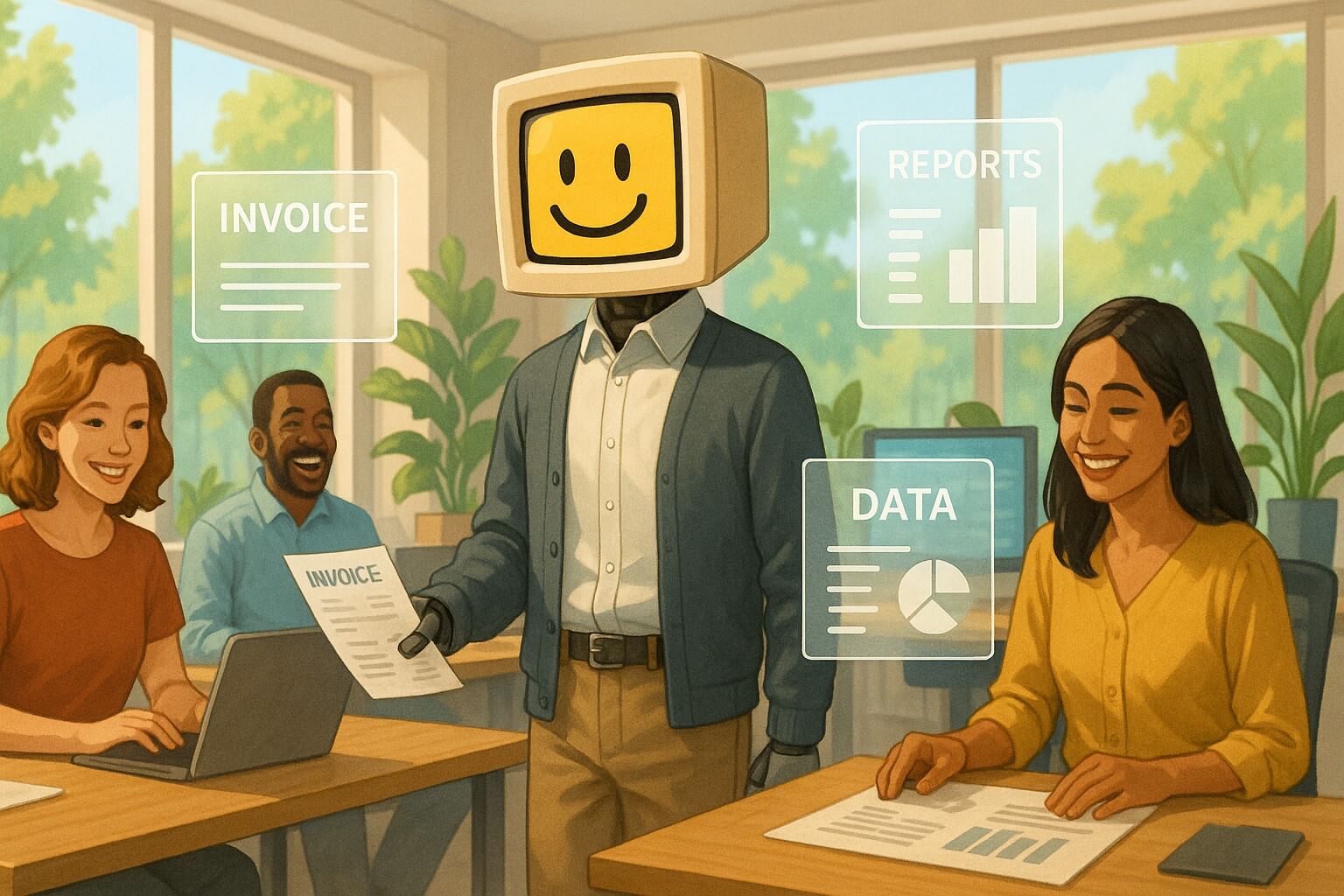The 5 Stages of AI & Automation Readiness: Where Is Your Business?
Not all businesses are at the same point in their automation journey. Discover which of the 5 stages your business is in and learn the best next steps to grow, scale, and achieve more with AI and automation.

Here’s the uncomfortable truth: not every business is ready for AI and automation. And that’s okay.
The automation journey isn’t a race. It’s a progression through distinct stages, and understanding where you are right now is the key to making smart decisions about where to invest your time, money, and energy next.
Some businesses are still running on paper and spreadsheets. Others have sophisticated, AI-driven systems humming in the background, handling thousands of tasks without human intervention. Most fall somewhere in between.
So where does your business fit? Let’s find out.
The 5 Stages of AI & Automation Readiness
Think of these stages as a roadmap. You can’t skip steps, but you can move through them intentionally, building the right foundation as you go.
Stage 1: Manual Operations
What it looks like:
- All work is done by hand, often on paper
- No digital systems managing your core business processes
- Schedules, invoices, customer records live in notebooks, whiteboards, or filing cabinets
- Information sharing happens verbally or through handwritten notes
Who’s here:
- Brand new businesses just getting off the ground
- Very small operations with one or two people
- Businesses in industries that have traditionally been low-tech
What to do: At this stage, AI and automation are probably overkill. Your first priority should be getting your core processes into digital systems. Start with the basics: a computer, a spreadsheet, maybe a simple invoicing tool.
The reality: You’re not behind. You’re just starting. Focus on finding software that solves your most pressing pain points first.
Stage 2: Point Solutions
What it looks like:
- You’re using CRMs or specialized apps to manage specific parts of your business
- Programs like HouseCall Pro, Jobber, QuickBooks, or industry-specific tools are handling tasks for you
- Scheduling, invoicing, customer management, and payments are digitized
- Each tool works independently, doing its own job well
Who’s here:
- Most businesses are at this stage
- You’ve adopted off-the-shelf software that fits your industry or function
- You’re seeing real value from these tools, but they don’t talk to each other
Examples:
- A contractor using HouseCall Pro to schedule jobs, track invoices, and manage payments
- A salon using Vagaro for appointments and client records
- An e-commerce store using Shopify for sales and Mailchimp for email marketing
What to do: Focus on mastering the tools you already have. Most software has features you’re not using yet. Dive into tutorials, explore automation features built into your existing apps, and get your team trained properly.
The reality: This is a smart, stable place to be. Off-the-shelf software gives you huge leverage at low cost. Don’t rush to the next stage until you’ve squeezed real value from what you already own.
Stage 3: Connected Ecosystems
What it looks like:
- You’re using multiple programs, and now you’re connecting them together
- Data flows between systems: your construction management software feeds into QuickBooks, your CRM syncs with your email marketing tool
- You’re thinking about business processes that span multiple platforms
- Native integrations and built-in connectors are handling the heavy lifting
Who’s here:
- Growing businesses with more complex operations
- Companies that have outgrown standalone tools
- Teams frustrated by re-entering the same data in multiple places
Examples:
- A construction company using BuilderTrend for project management and QuickBooks for accounting, with automatic sync between them
- A marketing agency connecting HubSpot CRM to their project management tool and invoicing system
- A retail business syncing inventory between Shopify, their warehouse system, and accounting software
What to do: Start mapping your business processes end-to-end. Where does information enter your business? Where does it need to go? Look for native integrations first, they’re usually the most reliable and require the least maintenance.
Signs you’re ready to move here:
- You’re copying data between systems regularly
- Errors are creeping in because information lives in multiple places
- You’re spending hours reconciling data across platforms
The reality: This is where things start to get interesting. Connecting your systems is the foundation of real automation. You’re building an ecosystem, not just using individual tools.
Stage 4: Custom Automation
What it looks like:
- You’re using tools like Zapier, Make, or custom scripts to automate workflows
- Emails are automatically categorized, routed, and acted upon
- Data moves between systems that weren’t designed to work together
- You have automations handling repetitive digital tasks without human intervention
- Low-code/no-code tools or custom development are part of your toolkit
Who’s here:
- Businesses where manual digital work has become a bottleneck
- Companies with repetitive processes that eat up hours every week
- Teams that have the time and resources to build and maintain custom solutions
Examples:
- Customer emails automatically parsed, categorized, and added to your CRM with follow-up tasks created
- When a sale closes in your CRM, a project is created in your PM tool, a folder is set up in Google Drive, and a welcome email is sent
- Automated data extraction from PDFs, invoices, or receipts, feeding directly into your accounting system
- Lead forms triggering multi-step nurture sequences across email, SMS, and CRM
What to do: Start small. Identify one repetitive task that takes 2-3 hours per week. Map out every step. Then build an automation to handle it. Test thoroughly. Monitor it. Only then move to the next task.
Signs you’re ready to move here:
- Your team complains about doing the same digital tasks over and over
- You’re hiring more people just to handle data entry or routine processing
- Growth is limited by your team’s capacity to handle repetitive work
- You have high turnover because the work is tedious
The reality: This is where automation starts to feel like magic. But it requires commitment. Custom automations need maintenance, monitoring, and occasional fixes. Budget time for upkeep, not just initial setup.
Stage 5: AI-Driven Intelligence
What it looks like:
- AI is integrated throughout your business processes, making decisions and routing work intelligently
- Systems don’t just move data, they understand it, categorize it, and act on it
- Humans supervise and approve rather than execute
- Your automations handle edge cases, learn from corrections, and improve over time
- You have custom interfaces and dashboards tailored to your specific workflows
Who’s here:
- Highly sophisticated operations with mature automation practices
- Companies that have invested heavily in process optimization
- Businesses where automation is a competitive advantage, not just a nice-to-have
Examples:
- AI reading incoming customer requests, determining intent, routing to the right team, drafting responses, and escalating only when needed
- Intelligent document processing that extracts data from invoices, receipts, contracts, and enters it into your systems with high accuracy
- Predictive systems that forecast demand, flag anomalies, and recommend actions
- Automated quality control and error detection with self-healing processes
What to do: At this stage, you’re not learning how to automate, you’re optimizing what you’ve already built. Focus on:
- Continuous improvement: Where can you shave off minutes or reduce errors?
- Business process re-engineering: Don’t just automate the old way, redesign workflows to be automation-native
- Prioritization: You have limited time and resources, which processes will give the biggest ROI?
- Scaling: How do you take what works and expand it across more areas of the business?
The reality: You’re doing great. Keep going. The work never stops, but the gains compound. Every new automation builds on the foundation you’ve created.
Where Is Your Business Right Now?
Take a moment and honestly assess where you are:
- Stage 1: We’re mostly manual, paper-based, or spreadsheet-driven
- Stage 2: We use software tools, but they don’t connect
- Stage 3: Our systems are integrated and share data
- Stage 4: We have custom automations and workflows
- Stage 5: AI makes decisions and routes work intelligently
There’s no judgment here. Every stage is valid. The goal is to understand where you are so you can make the right next move.
What to Do at Each Stage
If you’re at Stage 1 or 2:
Don’t jump to AI and automation yet.
Start by adopting proven, off-the-shelf software that fits your industry. Use your existing tools to their full potential. Automate what’s already built into the software.
AI and automation require a foundation. Build it first by going digital and mastering your core tools.
Focus on:
- Choosing software that fits your workflows
- Training your team to use it properly
- Digitizing manual processes
- Building good data hygiene habits
If you’re at Stage 3 or 4:
This is where AI and automation start to shine.
You’ve built the foundation. Now it’s time to automate the repetitive, time-consuming work that’s holding you back.
Signs you’re ready:
- You’re doing the same digital tasks repeatedly
- Your team is the bottleneck slowing down growth
- You’re spending hours on data entry, copying, or processing
- Hiring is hard, turnover is high, or you’re growing too fast to keep up
Focus on:
- Mapping your most repetitive processes
- Starting with one high-value, low-complexity automation
- Using tools like Zapier, Make, or working with an automation partner
- Testing, monitoring, and refining your automations
This is where AI and automation deliver massive ROI. You’re removing bottlenecks, freeing your team to do higher-value work, and scaling without linear increases in headcount.
If you’re at Stage 4 or 5:
You’re already leveraging automation. Now it’s about optimization and expansion.
You know how this works. You’ve seen the wins. Now you’re looking for the next opportunity, the next 10 hours you can save, the next error-prone process you can bulletproof.
Focus on:
- Identifying new areas for automation
- Improving existing automations (faster, smarter, more reliable)
- Business process re-engineering, don’t just automate the old way, redesign for automation
- Building a culture of continuous improvement
How to Know When You’re Ready to Move Forward
Moving to the next stage isn’t about following a timeline. It’s about recognizing the signals.
Move from Stage 1 to Stage 2 when:
- Manual processes are slowing you down
- You’re making mistakes because of disorganization
- You’re ready to invest in software
Move from Stage 2 to Stage 3 when:
- You’re re-entering the same data in multiple systems
- Data inconsistencies are causing problems
- You want processes that flow across tools without manual handoffs
Move from Stage 3 to Stage 4 when:
- Repetitive digital work is eating up hours every week
- Your team is maxed out and you need to scale
- Hiring or turnover is limiting your growth
- You’re willing to invest time in building and maintaining automations
Move from Stage 4 to Stage 5 when:
- Your automations are mature and stable
- You’re ready to add intelligence, not just workflows
- You want systems that learn, adapt, and improve
- You see automation as a competitive advantage worth investing in
The Bottom Line
AI and automation are powerful, but they’re not a magic fix for every business at every stage.
If you’re in Stage 1 or 2, focus on going digital and mastering your tools. Don’t rush into custom automation yet.
If you’re in Stage 3 or 4, this is your moment. Repetitive work is your bottleneck. Automation will free your team, accelerate growth, and give you back hours every week.
If you’re in Stage 4 or 5, keep going. Refine, optimize, expand. You’re building a competitive moat.
The key is knowing where you are, and taking the right next step.
Ready to Take the Next Step?
If you’re at Stage 3 or 4 and you’re ready to see how AI and automation can transform your business, we’d love to help.
At DigitalStaff, we specialize in helping businesses automate repetitive digital work, connect systems, and scale without adding headcount.
Start your free AI automation plan and we’ll help you identify your highest-value automation opportunities, or schedule a call to talk through where you are and where you want to go.
Let’s build the next stage of your business together.



